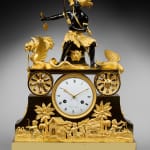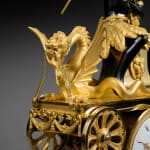Jacques-Claude-Martin Rocquet
Further images
Literature
"Musée François Duesberg: Arts Décoratifs (1775-1825)", circa 1975, p. 59, illustrating a clock of an identical model as well as another clock of a variant model with the American hunter seated in a boat mounted with a wolf head at its stern, a slightly different shaped plinth below and again with slightly different mounts, in the Musée François Duesberg, Mons. Pierre Kjellberg, "Encyclopédie de la Pendule Française du Moyen Age au XXe Siècle", 1997, p. 354, pl. B, illustrating the identical clock, with no dial signature, in the Musée François Duesberg, Mons. And p. 354, pl. C, illustrating the comparable clock with a wolf headed boat in the Musée François Duesberg, Mons. And p. 355, pl. D, illustrating a clock of identical design but with a completely gilt bronze plinth, save for the tops of the palm trees and three young hunters which are all picked out in patinated bronze. G. Wannenes, "Le Più Belle Pendole Francesi. Da Luigi XIV all'Impero", 1991, p. 150, illustrating a clock of the same model. Tardy, "Les Plus Belles Pendules Françaises", 1994, p. 244, illustrating a clock of a similar model with a boat mounted with a wolf head at its stern, formerly from the Gélis collection. Elke Niehüser, "Die Französische Bronzeuhr", 1997, p. 159, pl. 259, illustrating the comparable clock with the wolf headed boat instead of a chariot in the Musée François Duesberg at Mons in Belgium. And p. 237, pl. 800, illustrating an identical clock.
An extremely fine Directoire gilt and patinated bronze Pendule 'Au Chasseur Améridien' of eight day duration by Jacques-Claude-Martin Rocquet, signed on the white enamel dial Rocquet à Paris. The dial with Roman and Arabic numerals and a fine pair of gilt brass hands for the hours and minutes. The movement with anchor escapement, silk thread suspension, striking on the hour and half hour on a single bell, with outside count wheel.
The superb case with dial and milled foliate bezel set within a rectangular patinated bronze plinth with concave upper sides, surmounted by a chariot, its wheels with internal rosette mounted cut out spokes, set either side of the dial drum, the chariot supporting the figure of a native American hunter with white enamel eyes and wearing a plumed headdress and matching feathered skirt, hoop earrings, gilt arm bands and holding in his left hand a bow, and arrow in his outstretched right hand, with a quiver of arrows slung across his back, the hunter with straddled legs seated on a plinth mounted with a lion head mask, while looking to the left and having a dead eagle at his left foot and by his right foot a mythical winged beast with the head and clawed feet of a lion and forked serpentine tail while holding the reins of the chariot in his mouth. The patinated bronze plinth below the dial lavishly ornamented with gilt bronze mounts symbolising commerce with three black skinned putti amid rocks, a waterfall, palm trees and a hut, one putto with a bow and arrow, another seated with a dog and the other having just caught a fish, the plinth on a rectangular base on four turned feet
Paris, date circa 1800
Height 50.5cm, length 37cm, depth 12.5 cm.
Although rare, identical models of this imposing clock symbolising the Discovery of America or the New World, can be found at the Musée du Nouveau-Monde at La Rochelle as well as the Musée du François Duesberg in Mons, Belgium. The latter collection also houses a variant model which, instead of a chariot features an ancient type of boat with a wolf's head at its stern. The present clock features a movement by the esteemed Parisian clockmaker Jacques-Claude-Martin Rocquet (1765-1816); others were made by Alexandre, Onasse and Diot but some have no name of a maker on the white enamel dial.
The clock case itself reflects as fascinating period in history when, during the age of the Enlightenment, eighteenth century European society began questioning the morality and standards of its own civilisation in relation to the seeming innocence and untouched nature of those that lived in faraway exotic lands. This gave rise to the notion of le bon sauvage or noble savage as aired by Jean-Jacques Rousseau, whose 'Discourse on the Origin of Inequality', 1754 proposed that beauty and innocence of nature was extended from plants and trees. In 1767 the French explorer Bougainville arrived in Tahiti followed by Captain Cook in 1769. They returned with two of the islanders, Aotourous and Omai. The latter was taken to London where he was received by King George III and was painted by the celebrated portraitist Sir Joshua Reynolds. After hearing of the happy and harmonious life of the South Sea islanders, soon the brightest wits of Paris and London began to question their own corrupt European society in relation to the innocence of the native islanders. The notion of le bon sauvage also inspired some fine literary works such as Paul et Virginie (1787) by Bernardin de Saint-Pierre and Atala (1801) by Vicomte de Chateaubriand, which were the subject of some superb clock cases and like Daniel Defoe's Robinson Crusoe (1719) or Jonathan Swift's Gulliver's Travels (1724) encapsulated Europe's fascination with the exotic.
While the theme of the noble savage gained momentum during the end of the eighteenth century and continued during the early years of the next, Europeans had already begun portraying likenesses of the natives of America back in the sixteenth century, even though some of the representations were not entirely accurate. One of the earliest examples appeared on a carved choir screen dating from circa 1510, made for the chapel of the Normandy Château de Gaillon, which included two male figures wearing feathered skirts and headdresses. Likewise, a slightly earlier German engraving known as 'The First representation of the People of the New World', from Amerigo Vespucci, published in 1505, portrays the Tupinamba people of Brazil dressed in feathered headdresses and skirts. Bearded men carried bows and a spear while a group of women and children are seen feasting on parts of an unfortunate Portuguese traveller who is being roasted on an open fire.
Not all who encountered the Tupinambas suffered the same fate. For instance, the German explorer Hans Staden, who was captured by them in 1557, managed to survive and having returned to Europe, he published an illustrated account of his adventures, which provided European society with a wealth of information about these people. At about the same time as Staden's capture, two Frenchmen André Thevet and Jean de Léry, who had been involved with the short lived French colony near present day Rio de Janeiro, also reported their experiences of the New World in separate publications.
Likewise, during his voyages to America during the 1580s, the English artist John White made records of the Algonquians, who lived along the North Carolina coast and Roanoke Island. From the 1590s and based on White's watercolours, Theodore de Bry of Frankfurt began publishing a series of engravings, which like the gathering number of written publications helped inform European society of this distant civilisation. Alongside them, Europeans also began featuring personifications of the Four Continents, namely America, Africa, Asia and Europe (Australia not having yet been discovered). At first visual representations of the Four Continents appeared as engravings or in paintings but in time they inspired other arts, from porcelain, silver and clock cases. America was presented in the graphic arts as an Indian princess, sometimes wearing a crown or headdress, bejewelled anklets and feathered skirts and occasionally with a bow and arrows. Sometimes accompanied by an alligator, she was eventually and more generally represented as a beautiful dark skinned figure, with facial features that appear more African than American Indian. In contrast, America is here personified by a handsome native hunter who having just shot down an eagle is also shown as master over the mythical beast that pulls his chariot. Below him on the plinth is a scene representing commerce in the form of three native children who hunt and fish amid an idealised landscape.
Jacques-Claude-Martin Rocquet (1765-1816), who made the movement for this handsome clock was not only a fine clockmaker but a man of remarkable qualities who inherited his family's artistic entrepreneurial spirit. One of his ancestors built a chapel for the Medici family while his father Jacques-Martin Rocquet (also spelled Roquet) worked as a painter as well as fabric and costume designer for the Menus-Plaisirs du Roi and is known to have collaborated with the artists Boucher and Dominique-François Slodtz who also worked for the Menus-Plaisirs. Of interest when the latter died he left a sum of money to Jacques-Claude-Martin Rocquet's mother Marie Jeanne née Marion, who until his death had been married to Pierre-Jérôme Plé, marchand mercier-imprimeur et des Menus-Plaisirs du Roi.
Jacques-Claude-Martin Rocquet therefore grew up within an artistic milieu, firstly at rue du Bourg-Thilbourg, then at rue Tixeranderie, followed by rue St-Placide (1789) before being established at 34 rue Grenelle-Saint-Honoré, where he is assumed to have remained up until his death on 7th June 1816. At the outbreak of the French Revolution he became a sergeant in the Croix-Rouge section of the National Guard in Paris and a chief instructor of a battalion of volunteers. In June 1791, while commanding of a small detachment of Royalist soldiers, he successfully held the Hôtel des Missions Étrangères in rue du Bac against the mob and saved the lives of several nuns and priests. That act of bravery was fittingly acknowledged by Pope Pius VII, who sent to Rocquet a letter of praise with the papal blessing and a beautiful golden box. The same year of his heroic deed in 1791, he married Marie-Geneviève Force (b. c. 1775) at the church of Saint Leu in Paris. They had several children, one of whom became a maréchal, another a surgeon in the Grande army while Leopold Jacques Rocquet (1796-1851) emigrated to America as a young man and for many years worked as a jewellery maker in New Orleans. One wonders if Leopold had once seen a model of this clock case in his father's workshop, which in turn had sparked his desire to travel to America and experience for himself the opportunities that the New World could offer.





